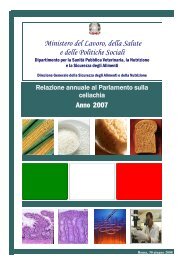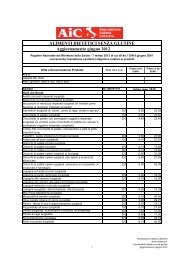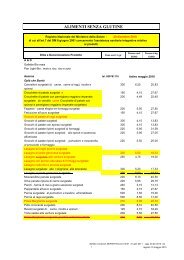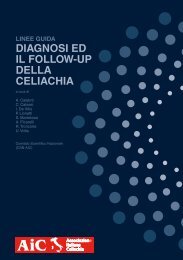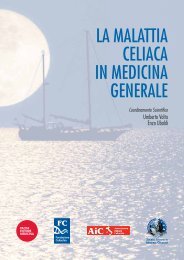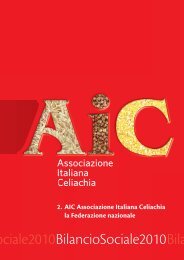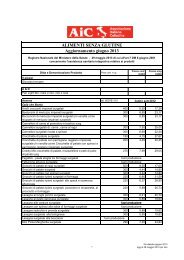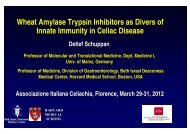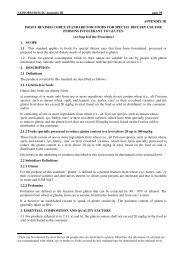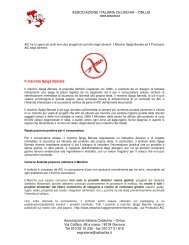primary prevention of coeliac disease - Associazione Italiana ...
primary prevention of coeliac disease - Associazione Italiana ...
primary prevention of coeliac disease - Associazione Italiana ...
Create successful ePaper yourself
Turn your PDF publications into a flip-book with our unique Google optimized e-Paper software.
44<br />
INFANT FEEDING PRACTICES AND COELIAC DISEASE<br />
20-23<br />
by means <strong>of</strong> a cascade <strong>of</strong> events results in a chronic enteropathy .<br />
The human leukocyte antigen (HLA)-DQ2 molecule is expressed by more than<br />
90% <strong>of</strong> <strong>coeliac</strong> <strong>disease</strong> patients, compared to 20-30% <strong>of</strong> healthy controls, and the<br />
22<br />
majority <strong>of</strong> the remaining patients express the DQ8 molecule . It has been estimated<br />
that the HLA-complex confers 40% <strong>of</strong> the sibling family risk, and that non-HLA genes<br />
24-25<br />
are the most important . However, efforts to identify these contributing non-HLA<br />
26-27<br />
genes have thus far not resulted in conclusive evidence . In assessing the impact <strong>of</strong><br />
genetics, the ratio lis crucial. This ratio is constructed by the prevalence in relatives <strong>of</strong><br />
28<br />
an affected individual over the prevalence within the general population . Thus, if<br />
causal environmental exposures are aggregated in the family, the impact <strong>of</strong> genetics<br />
29<br />
will be overestimated .<br />
Most common <strong>disease</strong>s have a multifactorial aetiology, and they thus develop<br />
through an interaction between an individual's genetic predisposition and various<br />
30<br />
environmental exposures . This has been shown for insulin dependent diabetes<br />
mellitus (IDDM), which is an autoimmune <strong>disease</strong> with many similarities to <strong>coeliac</strong><br />
<strong>disease</strong>. The immune system has a key function in the pathogenesis <strong>of</strong> both <strong>disease</strong>s,<br />
31<br />
and there is an increased risk for <strong>coeliac</strong> <strong>disease</strong> in persons with IDDM .<br />
It has recently been suggested that each genetic risk factor, taken separately, may<br />
frequently be present in the general population, and it is the combination <strong>of</strong> some <strong>of</strong><br />
26<br />
these and their interaction with environmental factors that induces <strong>coeliac</strong> <strong>disease</strong> .<br />
Thus, in addition to the mere presence <strong>of</strong> gluten in the diet, environmental exposures<br />
may also be expected to be part <strong>of</strong> the causal pattern responsible for <strong>coeliac</strong> <strong>disease</strong>.<br />
Failure <strong>of</strong> oral tolerance<br />
Environmental exposures, including infant feeding, influence the immunological<br />
32-34<br />
process resulting in oral tolerance - or intolerance - to a food constituent .<br />
Considering recent knowledge <strong>of</strong> the aetiology <strong>of</strong> <strong>coeliac</strong> <strong>disease</strong>, this may be viewed at<br />
least hypothetically as a failure in the development <strong>of</strong>, or the later loss <strong>of</strong>, oral<br />
35<br />
tolerance .<br />
In most individuals, oral tolerance towards gluten develops and prevails throughout<br />
life. If oral tolerance fails to develop, however, or is later broken down, then gluten may<br />
act like a “dangerous” foreign antigen, resulting in the development <strong>of</strong> <strong>coeliac</strong> <strong>disease</strong>.<br />
The Swedish epidemic<br />
Sweden has experienced an unusual epidemic <strong>of</strong> symptomatic <strong>coeliac</strong> <strong>disease</strong> in<br />
36-37<br />
children . The incidence reached levels higher than ever reported, and the decline<br />
that followed was amazingly abrupt (Fig. 1). Only children below two years <strong>of</strong> age were<br />
affected, and most <strong>of</strong> the cases had symptoms as severe as those that had been observed<br />
38-39<br />
earlier . These findings are based on our population-based prospective incidence<br />
register established in 1991, covering 40% <strong>of</strong> the Swedish child population, and<br />
36<br />
retrospective data collected back to 1973 from 15% <strong>of</strong> the child population .<br />
Recently it was shown that this was indeed an epidemic <strong>of</strong> <strong>coeliac</strong> <strong>disease</strong><br />
enteropathy, and not only a shift in the proportion <strong>of</strong> cases with symptomatic





